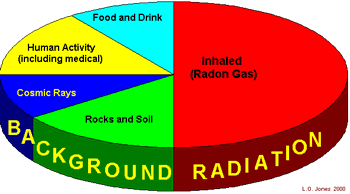Background
Radiation
Most of the background
radiation dose we receive in the UK is from natural sources (about
half is inhaled as radon gas). About 15% of our annual
dose comes from human activities such as X-rays in hospital or at
the dentist or emissions from nuclear establishments.
 Thus the figure on the right
is for 'Mr. Average in the UK'. Such data is worked out using the radiation
doses received by a lot of people living and working in a lot of different
locations.
Thus the figure on the right
is for 'Mr. Average in the UK'. Such data is worked out using the radiation
doses received by a lot of people living and working in a lot of different
locations.
The background dose
comes from five main sources:
 Food and drink
Food and drink
 Human activity
Human activity
 Cosmic rays
Cosmic rays
 Rocks and Soil
Rocks and Soil
 Radon
Radon
Some radiation sources are natural but human activities also raise the background count we are exposed to.
The radiation dose
you get in a year depends on:
 where you live
(the rock
type in your locality),
where you live
(the rock
type in your locality),
 your state of
health (whether you require treatment or investigation in hospital
that involves ionizing
radiation ),
your state of
health (whether you require treatment or investigation in hospital
that involves ionizing
radiation ),
 your diet (salt
substitutes contain potassium rather than sodium and the percentage
of potassium that naturally occurs in the radioactive
form is higher than that of sodium),
your diet (salt
substitutes contain potassium rather than sodium and the percentage
of potassium that naturally occurs in the radioactive
form is higher than that of sodium),
 your occupation (whether you work in an environment that exposes you to nuclear
radiation - such as a hospital or laboratory where nuclear isotopes are used)
your occupation (whether you work in an environment that exposes you to nuclear
radiation - such as a hospital or laboratory where nuclear isotopes are used)
 whether you smoke or not (cigarette smoke is known to contain dangerous alpha emitters).
whether you smoke or not (cigarette smoke is known to contain dangerous alpha emitters).
Measuring Backgrount Rate
 The activity from background radiation is called the background rate. If
a Geiger-counter is switched on in a room
it will register ionising radiation. This
will vary according to location.
The activity from background radiation is called the background rate. If
a Geiger-counter is switched on in a room
it will register ionising radiation. This
will vary according to location.
Before an
experiment with a radioactive source is carried out the background
rate must be established. This is done by switching on the Geiger-counter
when the source is not present and recording the average
activity for twenty minutes or so.
This value
must then be deducted from any readings taken with the source
present so that the true activity of the sample can be found.



 Thus the figure on the right
is for 'Mr. Average in the UK'. Such data is worked out using the radiation
doses received by a lot of people living and working in a lot of different
locations.
Thus the figure on the right
is for 'Mr. Average in the UK'. Such data is worked out using the radiation
doses received by a lot of people living and working in a lot of different
locations.  The
The 


